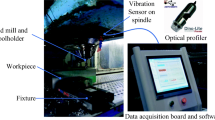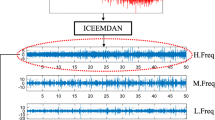Abstract
In machining processes, various phenomena occur during cutting operation. These phenomena can disturb the production through the reduction of part quality and accuracy. An easy way to control the process is by monitoring incontrollable parameters, such as generated temperature and vibration. The acquired vibration signals can provide information regarding tool life, surface roughness, cutting performances, and workpiece defects. This paper evaluates the possibility of monitoring the tool life during the turning process of AISI 1045 steel using laser Doppler vibrometer (LDV); the surface roughness has been measured along with the tool wear until reaching its limit value of 300μm. Furthermore, this paper also outlines the application of CEEMDAN technique to process the acquired signals for the monitoring processes. RMS and SCI indicators have been used to describe the wear progress, then, the artificial neural network has been adopted to achieve a real-time wear monitoring. The obtained results show that the CEEMDAN helps for isolating tool vibration signature. The RMS indicator does not provide enough information about the wear behavior; however, good results have been achieved by SCI indicator. The ANNs fed by SCI deliver accurate results allowing for real-time wear monitoring.
















Similar content being viewed by others
Data Availability
Not applicable
Code availability
Not applicable
References
Lauro CH, Brandão LC, Baldo D, Reis RA, Davim JP (2014) Monitoring and processing signal applied in machining processes–a review. Measurement 58:73–86
Dimla DE (2002) The correlation of vibration signal features to cutting tool wear in a metal turning operation. Int J Adv Manuf Technol 19(10):705–713
Zeng S, Wan X, Li W, Yin Z, Xiong Y (2012) A novel approach to fixture design on suppressing machining vibration of flexible workpiece. Int J Mach Tools Manuf 58:29–43
Devillez A, Dudzinski D (2007) Tool vibration detection with eddy current sensors in machining process and computation of stability lobes using fuzzy classifiers. Mech Syst Signal Process 21(1):441–456
Shahabi, H. H., and M. M. Ratnam. "On-line monitoring of tool wear in turning operation in the presence of tool misalignment." Int J Adv Manuf Technol 38.7-8 (2008): 718-727, 718.
Oo H, Wang W, Liu Z (2020) Tool wear monitoring system in belt grinding based on image-processing techniques. Int J Adv Manuf Technol 111(7):2215–2229
Hsieh W-H, Lu M-C, Chiou S-J (2012) Application of backpropagation neural network for spindle vibration-based tool wear monitoring in micro-milling. Int J Adv Manuf Technol 61(1-4):53–61
KHEMISSI BM, Ouelaa N, Djebala A (2017) Application of the empirical mode decomposition method for the prediction of the tool wear in turning operation. Mechanics 23(2):315–320
Raja JE, Kiong LC, Soong LW (2013) Hilbert–Huang transform-based emitted sound signal analysis for tool flank wear monitoring. Arab J Sci Eng 38(8):2219–2226
Babouri MK, Ouelaa N, Djebala A, Djamaa MC, Boucherit S (2017) Prediction of cutting tool’s optimal lifespan based on the scalar indicators and the wavelet multi-resolution analysis. In: In Applied Mechanics, Behavior of Materials, and Engineering Systems. Springer, Cham, pp 299–310
Babouri MK, Ouelaa N, Djamaa MC, Djebala A, Hamzaoui N (2017) Prediction of tool wear in the turning process using the spectral center of gravity. J Fail Anal Prev 17(5):905–913
Choi Y, Narayanaswami R, Chandra A (2004) Tool wear monitoring in ramp cuts in end milling using the wavelet transform. Int J Adv Manuf Technol 23(5):419–428
Rao KV, Murthy BSN, Rao NM (2013) Cutting tool condition monitoring by analyzing surface roughness, work piece vibration and volume of metal removed for AISI 1040 steel in boring. Measurement 46(10):4075–4084
Abu-Mahfouz I (2003) Drilling wear detection and classification using vibration signals and artificial neural network. Int J Mach Tools Manuf 43(7):707–720
Du M, Wang P, Wang J, Cheng Z, Wang S (2019) Intelligent turning tool monitoring with neural network adaptive learning. Complexity 2019:1–21
Xu X, Wang J, Ming W, Chen M, An Q (2021) In-process tap tool wear monitoring and prediction using a novel model based on deep learning. Int J Adv Manuf Technol 112(1):453–466
Wang X, Wang W, Huang Y, Nguyen N, Krishnakumar K (2008) Design of neural network-based estimator for tool wear modeling in hard turning. J Intell Manuf 19(4):383–396
Purushothaman S (2010) Tool wear monitoring using artificial neural network based on extended Kalman filter weight updation with transformed input patterns. J Intell Manuf 21(6):717–730
Sharma VS, Sharma SK, Sharma AK (2008) Cutting tool wear estimation for turning. J Intell Manuf 19(1):99–108
Aghdam BH, Vahdati M, Sadeghi MH (2015) Vibration-based estimation of tool major flank wear in a turning process using ARMA models. Int J Adv Manuf Technol 76(9-12):1631–1642
Cao X, Chen B, Yao B, Zhuang S (2019) An intelligent milling tool wear monitoring methodology based on convolutional neural network with derived wavelet frames coefficient. Appl Sci 9(18):3912
Liu H, Mi X, Li Y (2018) Comparison of two new intelligent wind speed forecasting approaches based on wavelet packet decomposition, complete ensemble empirical mode decomposition with adaptive noise and artificial neural networks. Energy Convers Manag 155:188–200
Nouioua M, Yallese MA, Khettabi R, Chabbi A, Mabrouki T, Girardin F (2017, March) Optimization of machining process during turning of X210Cr12 steel under MQL cooling as a key factor in clean production. In: International Conference Design and Modeling of Mechanical Systems. Springer, Cham, pp 855–863
Elbah M, Laouici H, Benlahmidi S, Nouioua M, Yallese MA (2019) Comparative assessment of machining environments (dry, wet and MQL) in hard turning of AISI 4140 steel with CC6050 tools. Int J Adv Manuf Technol 105(5):2581–2597
Nouioua M, Yallese MA, Khettabi R, Belhadi S, Mabrouki T (2017) Comparative assessment of cooling conditions, including MQL technology on machining factors in an environmentally friendly approach. Int J Adv Manuf Technol 91(9):3079–3094
Nouioua M, Yallese MA, Khettabi R, Belhadi S, Bouhalais ML, Girardin F (2017) Investigation of the performance of the MQL, dry, and wet turning by response surface methodology (RSM) and artificial neural network (ANN). Int J Adv Manuf Technol 93(5):2485–2504
Igba J, Alemzadeh K, Durugbo C, Eiriksson ET (2016) Analysing RMS and peak values of vibration signals for condition monitoring of wind turbine gearboxes. Renew Energy 91:90–106
Krimphoff J, McAdams S, Winsberg S (1994) Caractérisation du timbre des sons complexes. II Analyses acoustiques et quantification psychophysique Le Journal de Physique IV 4(C5):625
Acknowledgements
The machines, devices, and tools used in this work are the property of the Mechanics Research Center of Constantine.
Funding
The work is financed by the Algerian Ministry of Higher education and Scientific Research.
Author information
Authors and Affiliations
Corresponding author
Ethics declarations
Ethics approval
I certify that the paper follows the ethical rules of good scientific practice mentioned in the “Ethical Responsibilities of Authors” of the journal.
Human and animal rights consent
Not applicable
Consent to participate
Not applicable
Consent for publication
Mourad NOUIOUA hereby declare that I participated in the study and in the development of the manuscript titled (vibration-based tool wear monitoring using artificial neural networks fed by spectral centroid indicator and RMS of CEEMDAN modes) and authorize the full the publishing of manuscript data.
Conflict of interest
The authors declare no competing interests.
Additional information
Publisher’s note
Springer Nature remains neutral with regard to jurisdictional claims in published maps and institutional affiliations.
Rights and permissions
About this article
Cite this article
Nouioua, M., Bouhalais, M.L. Vibration-based tool wear monitoring using artificial neural networks fed by spectral centroid indicator and RMS of CEEMDAN modes. Int J Adv Manuf Technol 115, 3149–3161 (2021). https://doi.org/10.1007/s00170-021-07376-w
Received:
Accepted:
Published:
Issue Date:
DOI: https://doi.org/10.1007/s00170-021-07376-w




